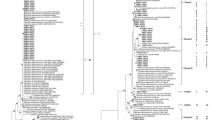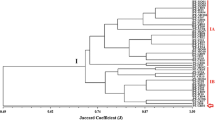Abstract
Leucaena leucocephala was introduced into Panxi, Sichuan, China, in the 1980s and 1990s for afforestation and preventing water loss and soil erosion in this area. The co-introduction of rhizobial symbionts of introduced plants has drawn attention since they may influence local soil communities. We studied the phylogenetic position of the L. leucocephala isolates and assessed if the rhizobia were introduced together with the host to Panxi, Sichuan, China. The glnII and atpD genes of fifteen representative isolates were sequenced and analyzed, and applied multilocus sequence analyses in which the housekeeping genes recA, glnII and atpD were included. Furthermore, we estimated the within species diversity directly with 23S rDNA and IGS RFLP and indirectly through phenotypic analysis of forty L. leucocephala isolates. The isolates represented seven species and 38 diversified strains in the genera Ensifer, Mesorhizobium, Bradyrhizobium and Rhizobium. The within species diversity of the Ensifer isolates was large, proposing a potential to occupy novel niches. There was not conclusive evidence to show that any of the strains would have been co-introduced with L. leucocephala. On the contrary, we came to a conclusion that the possible introduction should not be inferred from sequence data alone.






Similar content being viewed by others
References
Biondi EG, Tatti E, Comparini D, Giuntini E, Mocali S, Giovannetti L, Bazzicalupo M, Mengoni A, Viti C (2009) Metabolic capacity of Sinorhizobium (Ensifer) meliloti strains as determined by phenotype microArray analysis. Appl Environ Microbiol 75(16):5396–5404. doi:10.1128/AEM.00196-09
Clark MA, Moran NA, Baumann P (1999) Sequence evolution in bacterial endosymbionts having extreme base compositions. Mol Biol Evol 16(11):1586–1598
Degefu T, Wolde-meskel E, Frostegård Å (2011) Multilocus sequence analyses reveal several unnamed Mesorhizobium clade nodulating Acacia species and Sesbania sesban trees in Southern regions of Ethiopia. Syst Appl Microbiol 34:216–226. doi:10.1016/j.syapm.2010.09.006
Gao JL, Sun JG, Li Y, Wang ET, Chen WX (1994) Numerical taxonomy and DNA relatedness of tropical rhizobia isolated from Hainan province, China. Int J Syst Bacteriol 44:151–158. doi:10.1099/00207713-44-1-151
Gaunt MW, Tumer SL, Rigottier-Gois L, Lloyd-Macgilp SA, Young JPW (2001) Phylogenies of atpD and recA support the small subunit rRNA-based classification of rhizobia. Int J Syst Evol Microbiol 51(6):2037–2048. doi:10.1099/00207713-51-6-2037
Laguerre G, Mavingui P, Allard MR, Charnay MP, Louvrier P, Mazurier SI, Rigottier-Gois L, Amarger N (1996) Typing of rhizobia by PCR DNA fingerprinting and PCR-restriction fragment length polymorphism analysis of chromosomal and symbiotic gene regions: application to Rhizobium leguminosarum and its different biovars. Appl Environ Microbiol 62:2029–2036
Li QF, Zhang XP, Zou L, Chen Q, Fewer DP, Lindström K (2009) Horizontal gene transfer and recombination shape mesorhizobial populations in the gene center of the host plants Astragalus luteolus and Astragalus ernestii in Sichuan, China. FEMS Microbiol Ecol 70:227–235. doi:10.1111/j.1574-6941.2009.00776.x
Litchman E (2010) Invisible invaders: non-pathogenic invasive microbes in aquatic and terrestrial ecosystems. Ecol Lett 13:1560–1572. doi:10.1111/j.1461-0248.2010.01544.x
Liu XY, Wei S, Wang F, James EK, Guo XY, Zagar C, Xia LG, Dong X, Wang YP (2012) Burkholderia and Cupriavidus spp. are the preferred symbionts of Mimosa spp. in Southern China. FEMS Microbiol Ecol 80:417–426. doi:10.1111/j.1574-6941.2012.01310.x
Maddison WP (1997) Gene trees in species trees. Syst Biol 46(3):523–536. doi:10.2307/2413694
Martens M, Delaere M, Coopman R, De Vos P, Gillis M, Willems A (2007) Multilocus sequence analysis of Ensifer and related taxa. Int J Syst Evol Microbiol 57:489–503. doi:10.1099/ijs.0.64344-0
Martens M, Dawyndt P, Coopman R, Gillis M, Vos PD, Willems A (2008) Advantages of multilocus sequence analysis for taxonomic studies: a case study using 10 housekeeping genes in the genus Ensifer (including former Sinorhizobium). Int J Syst Evol Microbiol 58:200–214. doi:10.1099/ijs.0.65392-0
Moawad H, Bohlool BB (1984) Competition among Rhizobium spp. for nodulation of Leucaena leucocephala in two tropical soils. Appl Environ Microbiol 48:5–9
Ormeño-Orrillo E, Martínez-Romero E (2013) Phenotypic tests in Rhizobium species description: an opinion and (a sympatric speciation) hypothesis. Syst Appl Microbiol 36:145–147. doi:10.1016/j.syapm.2012.11.009
Pueppke SG, Broughton WJ (1999) Rhizobium sp. strain NGR234 and R. fredii USDA257 share exceptionally broad, nested host ranges. Mol Plant Microbe Interact 12:293–318. doi:10.1094/MPMI.1999.12.4.293
Richardson DM, Rejmánek M (2011) Trees and shrubs as invasive alien species—a global review. Divers Distrib 17:788–809. doi:10.1111/j.1472-4642.2011.00782.x
Richter M, Rosselló-Móra R (2009) Shifting the genomic gold standard for the prokaryotic species definition. PNAS 106:19126–19131. doi:10.1073/pnas.0906412106
Rivas R, Martens M, de Lajudie P, Willems A (2009) Multilocus sequence analysis of the genus Bradyrhizobium. Syst Appl Microbiol 32:101–110. doi:10.1016/j.syapm.2008.12.005
Rodríguez-Echeverría S (2010) Rhizobial hitchhikers from down under: invasional meltdown in a plant–bacteria mutualism? J Biogeogr 37:1611–1622. doi:10.1111/j.1365-2699.2010.02284.x
Rodríguez-Echeverría S, Fajardo S, Ruiz-Díez B, Fernández-Pascual M (2012) Differential effectiveness of novel and old legume-rhizobia mutualisms: implications for invasion by exotic legumes. Oecologia 170:253–261. doi:10.1007/s00442-012-2299-7
Somasegaran P, Martin RB (1986) Symbiotic characteristics and Rhizobium requirements of a Leucaena leucocephala × Leucaena diversifolia hybrid and its parental genotypes. Appl Environ Microbiol 52(6):1422–1424
Stackebrandt E, Frederiksen W, Garrity GM, Grimont PAD, Kämpfer P, Maiden MCJ, Nesme X, Rosselló-Mora R, Swings J, Trüper HG, Vauterin L, Ward AC, Whitman W (2002) Report of the ad hoc committee for the re-evaluation of the species definition in bacteriology. Int J Syst Evol Microbiol 52:1043–1047. doi:10.1099/ijs.0.02360-0
Tamura K, Peterson D, Peterson N, Stecher G, Nei M, Kumar S (2011) MEGA5: molecular evolutionary genetics analysis using maximum likelihood, evolutionary distance, and maximum parsimony methods. Mol Biol Evol 28(10):2731–2739. doi:10.1093/molbev/msr121
Terefework Z, Nick G, Suomalainen S, Paulin L, Lindström K (1998) Phylogeny of Rhizobium galegae with respect to other rhizobia and agrobacteria. Int J of Syst Bacteriol 48:349–356. doi:10.1099/00207713-48-2-349
Trinck MJ (1980) Relationships amongst the fast-growing rhizobia of Lablab purpureus, Leucaena leucocephala, Mimosa spp., Acacia farnesiana and Sesbania grandiflora and their affinities with other rhizobial groups. J Appl Bacteriol 49:39–53
Turner SL, Zhang XX, Li FD, Young JPW (2002) What does a bacterial genome sequence represent? Misassignment of MAFF303099 to the clade Mesorhizobium loti. Microbiology 148:3330–3331
van Berkum P, Terefework Z, Paulin L, Suomalainen S, Lindström K, Eardly BD (2003) Discordant phylogenies within the rrn loci of rhizobia. J Bacteriol 185:2988–2998. doi:10.1128/JB.185.10.2988-2998.2003
Vinuesa P, Silva C, Lorite MJ, Izaguirre-Mayoral ML, Bedmar EJ, Martínez-Romero E (2005) Molecular systematics of rhizobia based on maximum likelihood and Bayesian phylogenies inferred from rrs, atpD, recA and nifH sequences, and their use in the classification of Sesbania microsymbionts from Venezuelan wetlands. Syst Appl Microbiol 28:702–716. doi:10.1016/j.syapm.2005.05.007
Wang ET, Martínez-Romero J, Martínez-Romero E (1999) Genetic diversity of rhizobia from Leucaena leucocephala nodules in Mexican soils. Mol Ecol 8:711–724. doi:10.1046/j.1365-294X.1999.00608.x
Wang FQ, Wang ET, Zhang YF, Chen WX (2006) Characterization of rhizobia isolated from Albizia spp. in comparison with microsymbionts of Acacia spp. and Leucaena leucocephala grown in China. Syst Appl Microbiol 29:502–517. doi:10.1016/j.syapm.2005.12.010
Wei G, Chen W, Zhu W, Chen C, Young JPW, Bontemps C (2009) Invasive Robinia pseudoacacia in China is nodulated by Mesorhizobium and Sinorhizobium species that share similar nodulation genes with native American symbionts. FEMS Microbiol Ecol 68:320–328. doi:10.1111/j.1574-6941.2009.00673.x
Woffelman C (1994) DNAMAN for Windows, version 2.6. Lynon Biosoft, Institute of Molecular Plant Sciences, Leiden University, the Netherlands
Xu KW, Penttinen P, Chen YX, Chen Q, Zhang X (2013) Symbiotic efficiency and phylogeny of the rhizobia isolated from Leucaena leucocephala in arid-hot river valley area in Panxi, Sichuan, China. Appl Microbiol Biotechnol 97:783–793. doi:10.1007/s00253-012-4246-2
Yang JK, Yuan TY, Zhang WT, Zhou JC, Li YG (2008) Polyphasic characterization of mung bean (Vigna radiata L.) rhizobia from different geographical regions of China. Soil Biol Biochem 40:1681–1688. doi:10.1016/j.soilbio.2008.02.002
Zhou PF, Chen WM, Wei GH (2010) Mesorhizobium robiniae sp. nov., isolated from root nodules of Robinia pseudoacacia. Int J Syst Evol Microbiol 60:2552–2556. doi:10.1099/ijs.0.019356-0
Acknowledgments
This research was supported by National Natural Science Foundation of China (31070004) and Science and Technology Support Project of Sichuan Province of China (2012RZ0018).
Author information
Authors and Affiliations
Corresponding authors
Additional information
Kai Wei Xu and Petri Penttinen contributed equally to this work.
Electronic supplementary material
Below is the link to the electronic supplementary material.
Rights and permissions
About this article
Cite this article
Xu, K.W., Penttinen, P., Chen, Y.X. et al. Polyphasic characterization of rhizobia isolated from Leucaena leucocephala from Panxi, China. World J Microbiol Biotechnol 29, 2303–2315 (2013). https://doi.org/10.1007/s11274-013-1396-z
Received:
Accepted:
Published:
Issue Date:
DOI: https://doi.org/10.1007/s11274-013-1396-z




